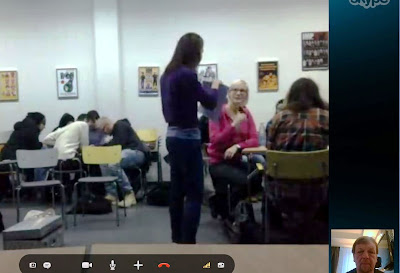 |
| Professors Bo Kim, Ziga Pavlovic, Jonas Janssen |
I thought I'd never really appreciate a presentation of film art not going deep into Russian avant-garde, Italian Neorealism, French and Czech New Waves, the Polish Film School and other holy film phenomena essential for Europe centric '60s radicals like myself. But this class really changed my mind. I think the professors didn't even mention Truffaut, Godard or Kaurismäki, but still (or because of that?) it was a wonderful and highly informative presentation of the most powerful (in my mind) form of the fine arts.
A very original and creative solution indeed to introduce film it was - not trough directors or actors or genres or schools - but relying on the magic of film art itself.
The session had two very important qualities: passion and interactivity. Both helped to make the show most captivating and attracting to interaction.
 |
| Feedback to team 1 |
 |
| Was this team 1 too? Did I fail to catch team 2 output? |
 |
| Team 3 |
 |
| Team4 |
The team assignments were entertaining like always, but were more educational than the previous. It is a pity there was not more time for the analysis and feedback on the tasks.
The professors triggered many discussions that unfortunately had to be cut short, but I hope they continue online.
 |
| The feedback team |
The written feedback of the feedback team is not posted when writing this, but they did a good job and I remember I agreed with them.
Teleporting
I have many times experienced the use of video conferencing to have a visiting expert contribute to a class. But this was the first time I participated in my own course from abroad. It was a good experience; it was almost like I would have teleported myself to Spede. The video was good quality (much better than in the snapshots illustrating this story) when there was not much movement. (The students coming late were really annoying this time.) The biggest problems I had with audio. Most of the time I could hear the speakers, but when a number of people were whispering, talking or moving the audio was useless. So silence in the class next time, please!
Thank you Róbert for helping me to be a part of this brilliant class!
 |
| Róbert - the Teleport Operator! |
 |
| Professor teleported from Berlin. Photo by Ziga Pavlovc (copied from a tweet by @zigaizcelja |
































